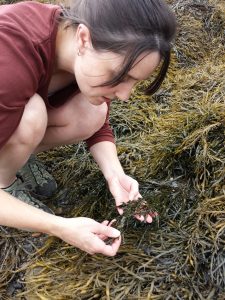Volunteer Spotlight: Elissa Koskela

Elissa joined the Signs of the Seasons team in 2014 as the program’s Assistant Coordinator. She enjoyed phenology so much that she has continued to be an observer ever since. “I was new to the science of phenology, but found it interesting that tracking local species could give insight to the larger picture of climate change in our region.”
“Participating in SOS has made me more aware of seasonal changes in general. I am more likely to poke through the spring grass looking for dandelion heads or wild strawberries. When I explore the intertidal, I pay closer attention to the species I find. I can see the changes from year to year and often wonder what the data would look like graphed over the long term.”
“Discussing climate change on a global or even regional scale can quickly become overwhelming. However, talking about something tangible, like the species that we encounter every day, makes the topic more approachable. Most people understand that plants and animals respond to cues in nature. It isn’t a stretch to say that changes in the timing of those cues would produce changes in behavior that can be measured in the timing. Through monitoring, I can talk to people about what I have seen and how long term shifts in these behaviors would signal a larger shift in the environment, climate change.”
Elissa observes coastal rockweed (Ascophyllum nodosum) in a publicly accessible site, so she often has people come up to ask about what she is doing: “I use these opportunities to explain the importance of rockweed in the intertidal and how its reproductive timing impacts the other species. Sometimes I’m able to recruit a budding scientist to comb through the fronds with me or help read the thermometer.”
Elissa recognizes that getting started as an observer can be a little daunting: “The first year of monitoring was definitely my most challenging. It can be hard to distinguish between the phenophases when you have only seen pictures of each phase. For intertidal species, that level of difficulty increases when trying to ID rockweed receptacles that have dried out. To really compare the texture and color, I flip the clump of fronds over and examine the wet seaweed that was hiding at the bottom.”
Thank you to Elissa for answering our questions and for all of the years that you have been a part of Signs of the Seasons!
